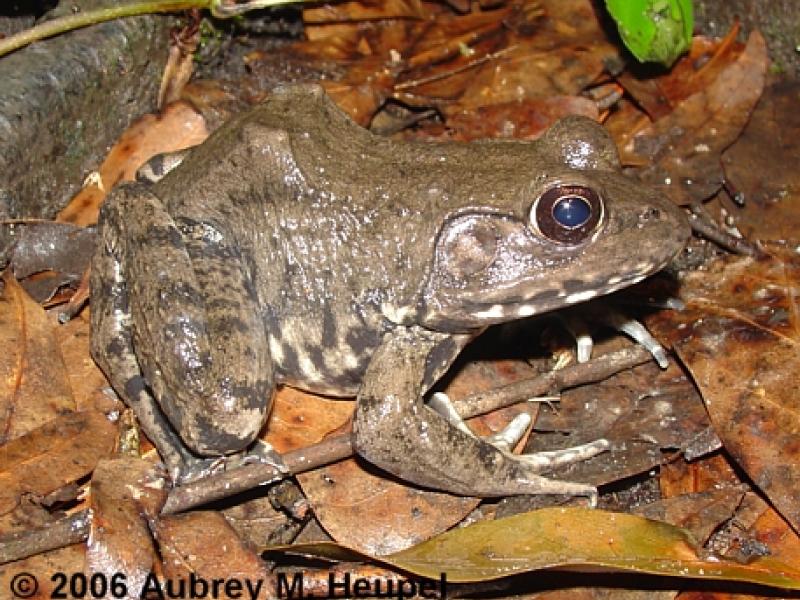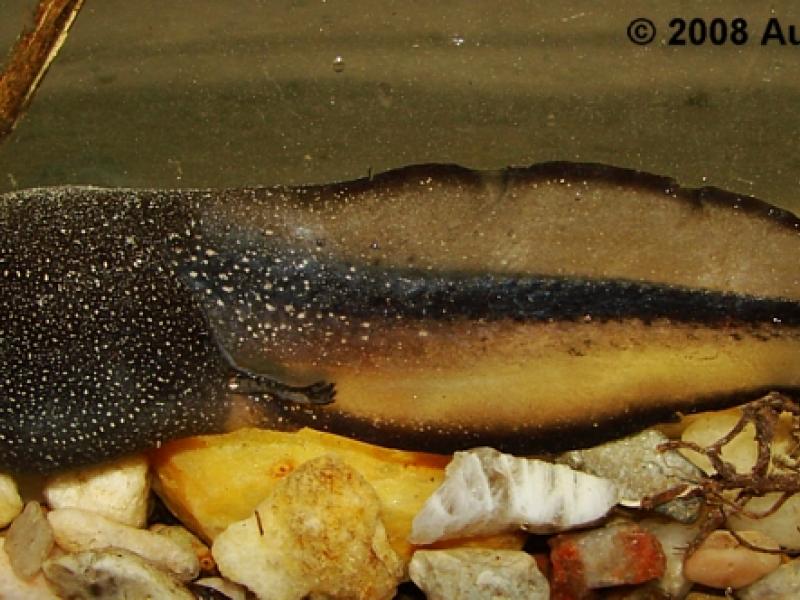Photo credits: Aubrey M. Heupel
SCIENTIFIC NAME:
Lithobates heckscheri (Wright)
STATUS:
Peripheral and rare in southern portion of Southern Pine Plains and Hills, and potentially in Dougherty Plain of southernmost tier of counties. Common in Florida and Georgia. Documented in Alabama from four old records. HIGHEST CONSERVATION CONCERN.
OTHER NAMES:
River-swamp Frog, Greenback, Heckscher’s Frog, Wright’s Bullfrog, Alligator Frog (Wright and Wright 1949).
DESCRIPTION:
A large (8-14 cm [3.1-5.5 in.] snout-vent length) dark brown to grayish olive frog (Mount 1975). Margins of upper and lower lips black with conspicuous white spots, especially on lower lip. Hind feet have extensive webbing; dorsolateral ridges absent (Wright 1924). Throat, belly, and underside of rear legs primarily gray or black, and mottled with white markings, especially toward rear legs, which distinguishes it from the bullfrog and pig frog whose undersides are mostly pure white or white with dark markings (Mount 1975). Skin texture rougher than that of the bullfrog and pig frog (Mount 1975). Small tadpoles black, with a gold or white transverse band on body (Wright 1924). Mature tadpole quite large (up to 16 cm [6.3 in.]) and has perhaps the most striking coloration of any southeastern ranid frog (Wright 1924, Mount 1975). Eye brick red and body black, dark gray, or dark greenish olive and evenly covered with fine gold or greenish-yellow flecks (Wright 1924). Upper portion of tail musculature very dark, but lighter below. Most distinctive feature of tadpole is black edge around entire tail fin, whereas tail fin is almost transparent (Wright 1924). Among North American ranid frogs, the river frog is part of the catesbeiana group that also includes the bullfrog and the pig, green, mink, carpenter, and bog frogs. Most recent phylogeny using rDNA restriction sites indicates the river and pig frogs are sister taxa and are most closely related to the carpenter frog (Hillis and Davis 1986).
DISTRIBUTION:
Restricted to lower Coastal Plain of the southeastern United States from the Lumber and Cape Fear Rivers in North Carolina, southward through southern Georgia to north-central Florida, and westward across the Florida Panhandle and southern Alabama into extreme southern Mississippi (Simmons and Hardy 1959, Mount 1975). In Alabama, known from only six localities in the extreme southern portion of the lower Coastal Plain in Mobile County (Franklin Creek), Baldwin County (Perdido and Styx Rivers), Escambia County (vicinity of Cedar Creek), and Henry County (Choctawhatchee River East Fork and Abbie Creek) (Mount 1975; K. Krysko, pers. comm.).
HABITAT:
Along rivers and smaller streams and in river floodplains including floodplain swamps and cut-off overflow pools (Wright 1924, Carr 1940). Also found in cypress-bordered lakes, forested swamps, bayheads, beaver impoundments, and borrow pits (Mount 1975). Primary requirement appears to be permanent water that is necessary for successful reproduction (i.e., metamorphosis). Primary vegetative associations appear to be bald cypress, tupelo-gum, titi, and bay (Mount 1975).
LIFE HISTORY AND ECOLOGY:
Little published data. In northern Florida, breeding occurs from April to August (Allen 1938). Calls vary from a snort to a grunt and guttural roll (Wright and Wright 1949). Eggs laid as a surface film and hatch in 10 to 15 days (Allen 1938). Tadpoles prefer shallow water and are found in densely packed schools of several hundred individuals, an uncommon behavioral feature among ranid frogs (Wright 1924). Schooling behavior in tadpoles is associated with predator avoidance and food location (Altig and Christensen 1981). Tadpoles require about 10-12 months to transform, and they apparently overwinter (Allen 1938). They remain active in winter months, but growth is slower (Hansen 1957). In the Florida Panhandle, large individuals without limb buds have been observed in March and transforming individuals in April (M. Aresco, pers. observ.). Large tadpoles also have been observed in September. Newly metamorphosed specimens are about 60 millimeters (2.4 inches) snout-vent length (75 percent of adult size), a large body size relative to metamorphs of other ranid frog species. Juveniles grow rapidly during the first year (average growth rate of 8 mm [0.3 in.] per month), and probably reach mature size within one year after metamorphosis (Hansen 1957). Adults are active at air temperatures of 18o to 35oC (64.4 to 95oF) and are nocturnal, usually found sitting on the bank facing the water (Carr 1940, Hansen 1957). Adults apparently forage on land but stay close to water, probably feeding on a wide range of invertebrates, especially crayfish. When adults are captured, they become limp and relaxed in contrast to bullfrogs and pig frogs that kick and struggle vigorously (Carr 1940).
BASIS FOR STATUS CLASSIFICATION:
Distribution in Alabama extremely restricted and, despite the prevalence of apparently suitable habitat in southern Alabama, have only been found at six isolated localities (Mount 1975). Museum records and field observations by herpetologists occurred sporadically between the 1950s and the late 1970s, but there are no records in the last 25 years. Therefore, this species is extremely rare in Alabama. Recent surveys for tadpoles in the nearby Florida Panhandle (e.g., OchlockoneeRiver, ApalachicolaNational Forest) indicate that it is still locally common in other parts of its distribution, so it is not clear why, or if, it is absent from historic localities in Alabama. Although the historic abundance in Alabama is unknown, its rarity warrants its current designation. Loss and degradation of river floodplain habitat is undoubtedly detrimental. Intensive logging and drainage of bottomland forest and swamps has probably reduced populations through direct habitat loss and associated effects, such as siltation and hydrologic changes.
Author: Matthew J. Aresco







